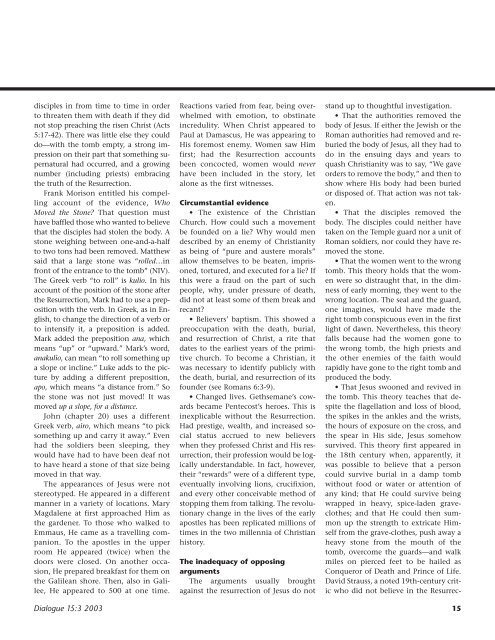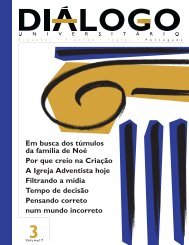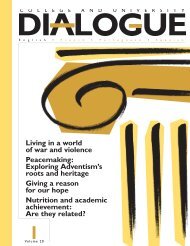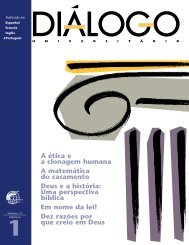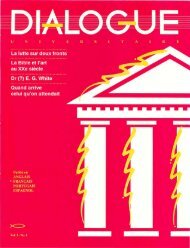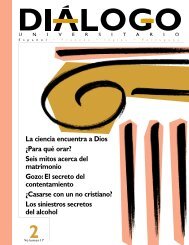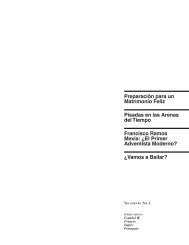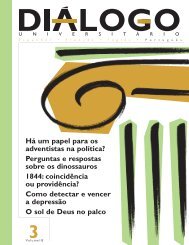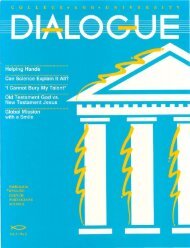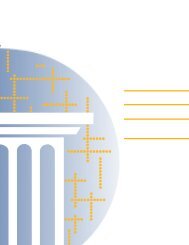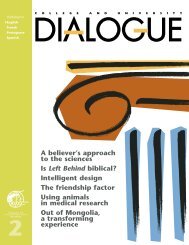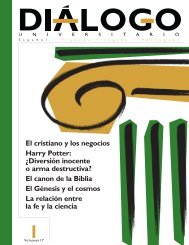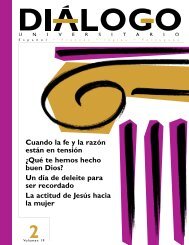Faith, reason, and the educated Christian Creationism - College and ...
Faith, reason, and the educated Christian Creationism - College and ...
Faith, reason, and the educated Christian Creationism - College and ...
Create successful ePaper yourself
Turn your PDF publications into a flip-book with our unique Google optimized e-Paper software.
disciples in from time to time in order<br />
to threaten <strong>the</strong>m with death if <strong>the</strong>y did<br />
not stop preaching <strong>the</strong> risen Christ (Acts<br />
5:17-42). There was little else <strong>the</strong>y could<br />
do—with <strong>the</strong> tomb empty, a strong impression<br />
on <strong>the</strong>ir part that something supernatural<br />
had occurred, <strong>and</strong> a growing<br />
number (including priests) embracing<br />
<strong>the</strong> truth of <strong>the</strong> Resurrection.<br />
Frank Morison entitled his compelling<br />
account of <strong>the</strong> evidence, Who<br />
Moved <strong>the</strong> Stone? That question must<br />
have baffled those who wanted to believe<br />
that <strong>the</strong> disciples had stolen <strong>the</strong> body. A<br />
stone weighing between one-<strong>and</strong>-a-half<br />
to two tons had been removed. Mat<strong>the</strong>w<br />
said that a large stone was “rolled…in<br />
front of <strong>the</strong> entrance to <strong>the</strong> tomb” (NIV).<br />
The Greek verb “to roll” is kulio. In his<br />
account of <strong>the</strong> position of <strong>the</strong> stone after<br />
<strong>the</strong> Resurrection, Mark had to use a preposition<br />
with <strong>the</strong> verb. In Greek, as in English,<br />
to change <strong>the</strong> direction of a verb or<br />
to intensify it, a preposition is added.<br />
Mark added <strong>the</strong> preposition ana, which<br />
means “up” or “upward.” Mark’s word,<br />
anakulio, can mean “to roll something up<br />
a slope or incline.” Luke adds to <strong>the</strong> picture<br />
by adding a different preposition,<br />
apo, which means “a distance from.” So<br />
<strong>the</strong> stone was not just moved! It was<br />
moved up a slope, for a distance.<br />
John (chapter 20) uses a different<br />
Greek verb, airo, which means “to pick<br />
something up <strong>and</strong> carry it away.” Even<br />
had <strong>the</strong> soldiers been sleeping, <strong>the</strong>y<br />
would have had to have been deaf not<br />
to have heard a stone of that size being<br />
moved in that way.<br />
The appearances of Jesus were not<br />
stereotyped. He appeared in a different<br />
manner in a variety of locations. Mary<br />
Magdalene at first approached Him as<br />
<strong>the</strong> gardener. To those who walked to<br />
Emmaus, He came as a travelling companion.<br />
To <strong>the</strong> apostles in <strong>the</strong> upper<br />
room He appeared (twice) when <strong>the</strong><br />
doors were closed. On ano<strong>the</strong>r occasion,<br />
He prepared breakfast for <strong>the</strong>m on<br />
<strong>the</strong> Galilean shore. Then, also in Galilee,<br />
He appeared to 500 at one time.<br />
Dialogue 15:3 2003<br />
Reactions varied from fear, being overwhelmed<br />
with emotion, to obstinate<br />
incredulity. When Christ appeared to<br />
Paul at Damascus, He was appearing to<br />
His foremost enemy. Women saw Him<br />
first; had <strong>the</strong> Resurrection accounts<br />
been concocted, women would never<br />
have been included in <strong>the</strong> story, let<br />
alone as <strong>the</strong> first witnesses.<br />
Circumstantial evidence<br />
• The existence of <strong>the</strong> <strong>Christian</strong><br />
Church. How could such a movement<br />
be founded on a lie? Why would men<br />
described by an enemy of <strong>Christian</strong>ity<br />
as being of “pure <strong>and</strong> austere morals”<br />
allow <strong>the</strong>mselves to be beaten, imprisoned,<br />
tortured, <strong>and</strong> executed for a lie? If<br />
this were a fraud on <strong>the</strong> part of such<br />
people, why, under pressure of death,<br />
did not at least some of <strong>the</strong>m break <strong>and</strong><br />
recant?<br />
• Believers’ baptism. This showed a<br />
preoccupation with <strong>the</strong> death, burial,<br />
<strong>and</strong> resurrection of Christ, a rite that<br />
dates to <strong>the</strong> earliest years of <strong>the</strong> primitive<br />
church. To become a <strong>Christian</strong>, it<br />
was necessary to identify publicly with<br />
<strong>the</strong> death, burial, <strong>and</strong> resurrection of its<br />
founder (see Romans 6:3-9).<br />
• Changed lives. Gethsemane’s cowards<br />
became Pentecost’s heroes. This is<br />
inexplicable without <strong>the</strong> Resurrection.<br />
Had prestige, wealth, <strong>and</strong> increased social<br />
status accrued to new believers<br />
when <strong>the</strong>y professed Christ <strong>and</strong> His resurrection,<br />
<strong>the</strong>ir profession would be logically<br />
underst<strong>and</strong>able. In fact, however,<br />
<strong>the</strong>ir “rewards” were of a different type,<br />
eventually involving lions, crucifixion,<br />
<strong>and</strong> every o<strong>the</strong>r conceivable method of<br />
stopping <strong>the</strong>m from talking. The revolutionary<br />
change in <strong>the</strong> lives of <strong>the</strong> early<br />
apostles has been replicated millions of<br />
times in <strong>the</strong> two millennia of <strong>Christian</strong><br />
history.<br />
The inadequacy of opposing<br />
arguments<br />
The arguments usually brought<br />
against <strong>the</strong> resurrection of Jesus do not<br />
st<strong>and</strong> up to thoughtful investigation.<br />
• That <strong>the</strong> authorities removed <strong>the</strong><br />
body of Jesus. If ei<strong>the</strong>r <strong>the</strong> Jewish or <strong>the</strong><br />
Roman authorities had removed <strong>and</strong> reburied<br />
<strong>the</strong> body of Jesus, all <strong>the</strong>y had to<br />
do in <strong>the</strong> ensuing days <strong>and</strong> years to<br />
quash <strong>Christian</strong>ity was to say, “We gave<br />
orders to remove <strong>the</strong> body,” <strong>and</strong> <strong>the</strong>n to<br />
show where His body had been buried<br />
or disposed of. That action was not taken.<br />
• That <strong>the</strong> disciples removed <strong>the</strong><br />
body. The disciples could nei<strong>the</strong>r have<br />
taken on <strong>the</strong> Temple guard nor a unit of<br />
Roman soldiers, nor could <strong>the</strong>y have removed<br />
<strong>the</strong> stone.<br />
• That <strong>the</strong> women went to <strong>the</strong> wrong<br />
tomb. This <strong>the</strong>ory holds that <strong>the</strong> women<br />
were so distraught that, in <strong>the</strong> dimness<br />
of early morning, <strong>the</strong>y went to <strong>the</strong><br />
wrong location. The seal <strong>and</strong> <strong>the</strong> guard,<br />
one imagines, would have made <strong>the</strong><br />
right tomb conspicuous even in <strong>the</strong> first<br />
light of dawn. Never<strong>the</strong>less, this <strong>the</strong>ory<br />
falls because had <strong>the</strong> women gone to<br />
<strong>the</strong> wrong tomb, <strong>the</strong> high priests <strong>and</strong><br />
<strong>the</strong> o<strong>the</strong>r enemies of <strong>the</strong> faith would<br />
rapidly have gone to <strong>the</strong> right tomb <strong>and</strong><br />
produced <strong>the</strong> body.<br />
• That Jesus swooned <strong>and</strong> revived in<br />
<strong>the</strong> tomb. This <strong>the</strong>ory teaches that despite<br />
<strong>the</strong> flagellation <strong>and</strong> loss of blood,<br />
<strong>the</strong> spikes in <strong>the</strong> ankles <strong>and</strong> <strong>the</strong> wrists,<br />
<strong>the</strong> hours of exposure on <strong>the</strong> cross, <strong>and</strong><br />
<strong>the</strong> spear in His side, Jesus somehow<br />
survived. This <strong>the</strong>ory first appeared in<br />
<strong>the</strong> 18th century when, apparently, it<br />
was possible to believe that a person<br />
could survive burial in a damp tomb<br />
without food or water or attention of<br />
any kind; that He could survive being<br />
wrapped in heavy, spice-laden graveclo<strong>the</strong>s;<br />
<strong>and</strong> that He could <strong>the</strong>n summon<br />
up <strong>the</strong> strength to extricate Himself<br />
from <strong>the</strong> grave-clo<strong>the</strong>s, push away a<br />
heavy stone from <strong>the</strong> mouth of <strong>the</strong><br />
tomb, overcome <strong>the</strong> guards—<strong>and</strong> walk<br />
miles on pierced feet to be hailed as<br />
Conqueror of Death <strong>and</strong> Prince of Life.<br />
David Strauss, a noted 19th-century critic<br />
who did not believe in <strong>the</strong> Resurrec-<br />
15


